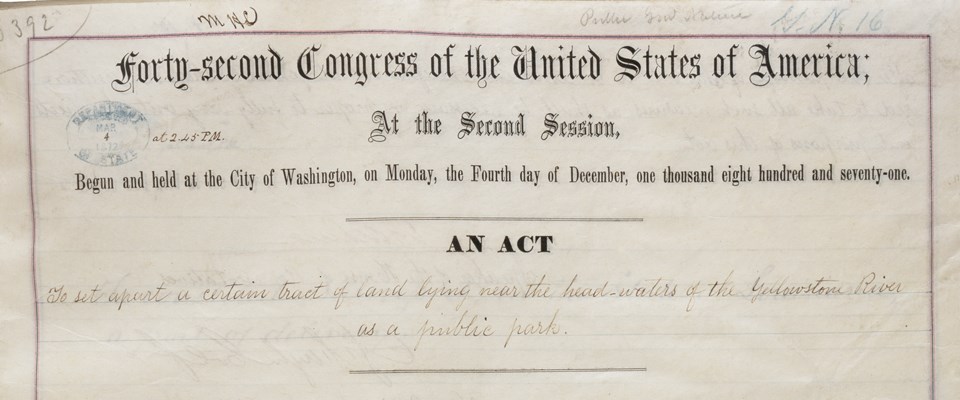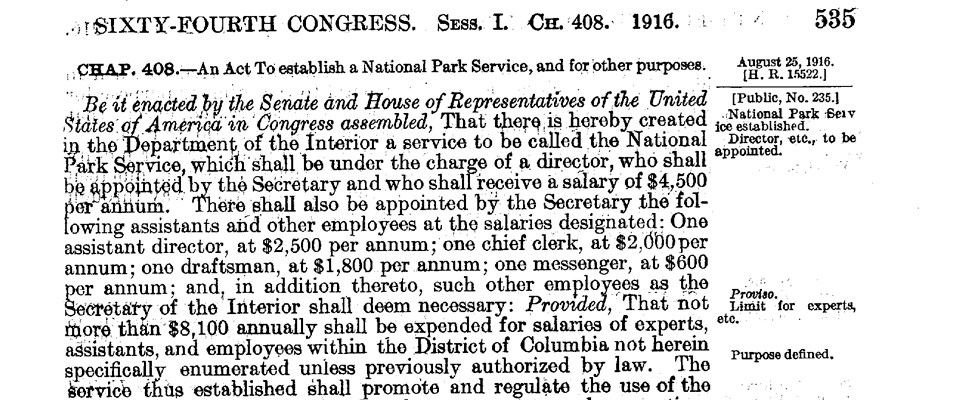Yellowstone National Park Protection Act, 1872

“AN ACT to set apart a certain tract of land lying near the headwaters of the Yellowstone River as a public park.
Be it enacted by the Senate and House of Representatives of the United States of America in Congress assembled, That the tract of land in the Territories of Montana and Wyoming, lying near the headwaters of the Yellowstone River, and described as follows, to wit, commencing at the junction of Gardiner’s river with the Yellowstone river, and running east to the meridian passing ten miles to the eastward of the most eastern point of Yellowstone lake; thence south along said meridian to the parallel of latitude passing ten miles south of the most southern point of Yellowstone lake; thence west along said parallel to the meridian passing fifteen miles west of the most western point of Madison lake; thence north along said meridian to the latitude of the junction of Yellowstone and Gardiner’s rivers; thence east to the place of beginning, is hereby reserved and withdrawn from settlement, occupancy, or sale under the laws of the United States, and dedicated and set apart as a public park or pleasuring-ground for the benefit and enjoyment of the people; and all persons who shall locate or settle upon or occupy the same, or any part thereof, except as hereinafter provided, shall be considered trespassers and removed therefrom.”
The Yellowstone Act of 1872 established the first national park in the United States. The bill was passed by Congress on March 1, 1872 and signed into law by President Ulysses S. Grant. It was the result of the work of Ferdinand Vandiveer Hayden, who was commissioned by the government to survey the land in 1871. This designation preserved land in what is today Wyoming, Montana, and Idaho and prohibited any settlers or development of the land. The park was placed under the control of the Secretary of the Interior, as the National Park Service would not be established as a separate agency until the 1900s. As the first national park, Yellowstone set a precedent for future national parks, although the next national park, Yosemite, would not be established until 1890. Since the creation of Yellowstone almost 150 years ago, 60 more parks have been established.
National Park Service Organic Act, 1916

The National Park Service Organic Act was passed by Congress on August 25, 1916. It was signed into law by President Woodrow Wilson. The act established a service under the Department of Interior called the National Park Service (NPS). Prior to the establishment of the NPS, the national parks were under the jurisdiction of multiple government agencies. By creating a specific service dedicated to the national parks, with a director and several employees, the parks were managed more effectively. Creating a separate agency also demonstrated the federal government’s commitment to environmental, historic, and cultural preservation. In the decades after the Organic Act, the National Park Service expanded to include other nationally designated areas including national historic sites, national seashores, and national monuments.
Historic Sites Act, 1935
“It is declared that it is a national policy to preserve for public use historic sites, buildings, and objects of national significance for the inspiration and benefit of the people of the United States.”
The Historic Sites Act was passed in 1935 and gave the National Park Service (NPS) the power to preserve historic sites. As a result of the act, the NPS was given the power to conduct surveys to determine which sites to preserve, then to obtain, restore, and maintain the sites. After restoring the sites to their original status, the NPS opened them to the public and created educational programs and exhibits within the sites. While the preservation and restoration were important, the interpretation of the sites was more important. The NPS had the power to shape educational exhibits to present history in a certain way, potentially glorifying problematic figures or creating one-sided views of an event. The act was passed in the midst of the Great Depression and was part of a movement to preserve the cultural history of the United States. The Civilian Conservation Corps was assigned by the NPS to help with the preservation of sites. The Historic Sites Act expanded the National Park Service to encompass a broader scope that included historical preservation in addition to environmental preservation.
“Theodore Roosevelt and John Muir on Glacier Point, Yosemite Valley, California, in 1903”
In this 1903 photograph, President Theodore Roosevelt and John Muir pose in Yosemite National Park. They are the main focus of the image; it is difficult to see the beauty of the area because the image is in black and white, although there are snowcapped mountains and a waterfall in the background. Both Roosevelt and Muir played major roles in establishing the early national parks. Roosevelt was known for being an enthusiastic outdoorsman and established five national parks as president. Theodore Roosevelt National Park, in North Dakota, was named after him in honor of his love of nature and his work in building the national park program. Muir was a famous environmentalist who wrote about his experiences in nature, particularly in Yosemite and the Sierra Nevada Mountains and petitioned for the creation of Yosemite National Park, which was established in 1890. Without the work of both men, it is likely that the national parks would not be as successful or as numerous.
“Turning America’s Wilderness Into National Parks,” The Sunday Star, 1929

“Dear Steve: If you don’t like the way the national parks are being run, why don’t you come down here to Washington and run them yourself?”
-Franklin K. Lane, Secretary of the Interior, in response to Mather’s complaints about the national parks
This article in The Sunday Star chronicles the life of Stephen Mather, the first director of the National Park Service. It is highly complementary of Mather and discusses how he became the director and his contributions to the parks. The article explains that after Mather visited several of the national parks, he wrote to the government complaining about the state of the parks. In response, the Secretary of the Interior invited him to run the parks. In the article, Horace Albright describes Mather as a very personable man who easily made friends. Albright worked under Mather as his assistant and took his position as director of the National Park Service when Mather retired. The article was written because Mather retired after 12 years as director, and it was published in February 1929. Mather resigned for health reasons and passed away the following winter.

![[Theodore Roosevelt and John Muir on Glacier Point, Yosemite Valley, California, in 1903]](https://cdn.loc.gov/service/pnp/ppmsca/36400/36413r.jpg)